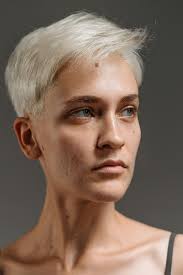Unlocking the Mystery: Understanding Why Young People have White Hair

While it’s true that aging is commonly associated with graying hair, the reality is that individuals of all ages can experience this phenomenon. So, why do young people have white hair? One prominent factor contributing to premature graying is genetics.
Just as our genetic makeup influences various aspects of our physical appearance, it also plays a significant role in determining the timing and extent of graying. If your parents or grandparents experienced early graying, there’s a higher likelihood that you may follow suit.
The Fascination with Premature Graying
Despite its perplexing nature, premature graying has captivated the curiosity of scientists, health enthusiasts, and individuals experiencing this phenomenon. Understanding the complexities of why young people have white hair requires delving into the intricate mechanisms of hair pigmentation and the myriad factors influencing it.
Understanding Hair Pigmentation
Exploring the Fundamentals of Hair Color
A delicate interplay of biochemical processes within hair follicles governs hair coloration. Central to this process is the presence of melanin, a pigment responsible for the diverse spectrum of hair colors observed in humans.
Melanin: The Master Molecule
Melanin, produced by specialized cells called melanocytes, serves as the primary determinant of hair color. Its synthesis and distribution within the hair shaft contribute to variations in color intensity and hue.
Eumelanin vs. Pheomelanin: The Dynamic Duo
Two main types of melanin, eumelanin and pheomelanin, work in concert to produce different shades of hair color. Eumelanin imparts darker tones, while pheomelanin contributes to lighter hues.
Genetics and Hair Color
Deciphering the Genetic Blueprint
Genetic factors play a crucial role in determining an individual’s hair color. The inheritance of specific genes dictates the production and distribution of melanin, shaping the hair’s natural coloration.
Patterns of Inheritance: Cracking the Code
The inheritance patterns of hair color follow complex genetic mechanisms, influenced by multiple genes inherited from parents. Understanding these patterns can provide insights into the likelihood of certain hair color outcomes.
Genetic Mutations: Disrupting the Balance
Alterations or mutations in genes associated with melanin production can disrupt the balance of eumelanin and pheomelanin, leading to deviations from normal hair coloration. Such genetic anomalies may manifest as why these young people have white hair
Why young people have white hair: Causes and Contributing Factors
Unraveling the Stress-Graying Connection
While stress is often implicated as a potential cause of premature graying, scientific evidence supporting this notion remains inconclusive. Nonetheless, chronic stress may exacerbate existing genetic predispositions to premature graying.

Cortisol’s Role in Hair Pigmentation
The stress hormone cortisol has been hypothesized to influence hair pigmentation by disrupting melanin production processes. Elevated cortisol levels, triggered by chronic stress, may accelerate the aging of hair follicles and contribute to premature graying.
Impact of Lifestyle Choices
Dietary Influences on Hair Health
Nutritional deficiencies or imbalances can adversely affect hair health and pigmentation. Consuming a diet rich in essential nutrients, such as vitamins, minerals, and antioxidants, supports optimal hair growth and color retention.
The Smoking Paradox: Nicotine and Graying
Cigarette smoking has been associated with an increased risk of premature graying, despite nicotine’s vasoconstrictive properties. The exact mechanisms underlying this paradoxical relationship between smoking and graying warrant further investigation.
Medical Conditions and Their Effect on Hair Color
Vitiligo: Beyond Skin Deep
Vitiligo, a chronic autoimmune condition characterized by depigmented patches on the skin, can affect anyone and hair pigmentation. Loss of melanocytes within hair follicles may result in why young people have white hair in some affected areas.
Thyroid Troubles: Affecting Hair Pigmentation
Disorders of the thyroid gland, such as hypothyroidism or hyperthyroidism, can disrupt normal hair pigmentation processes. Hormonal imbalances associated with thyroid dysfunction may contribute to premature graying in affected individuals.
Psychological Aspects of Premature Graying
Navigating Emotional Turbulence
The onset of premature graying can evoke a range of emotional responses, including feelings of shock, embarrassment, or insecurity. Coping mechanisms and emotional support networks play crucial roles in helping individuals navigate these turbulent emotions.
Self-Image and Identity Crisis
Premature graying may challenge individuals’ perceptions of self-image and identity, particularly in cultures where youthfulness is highly valued. Acceptance and self-confidence are essential for fostering resilience in the face of changing appearance.
Mental Health Implications
The psychological impact of premature graying extends beyond surface-level concerns, potentially affecting individuals’ overall mental well-being. Addressing underlying psychological distress is paramount for maintaining positive mental health outcomes.
Dispelling Myths and Misconceptions
Stress: Not the Sole Culprit
While stress is commonly cited as a factor in young people having,grey hair its role may be overstated. Other genetic, environmental, and lifestyle factors also contribute to variations in hair pigmentation and aging.
Dietary Supplements: Miracle or Mirage?
The efficacy of dietary supplements in preventing or reversing premature graying remains a subject of debate. While certain nutrients may support overall hair health, limited scientific evidence supports their specific role in combating graying.
Hair Care Products: Separating Fact from Fiction
Advertisements for hair care products often tout their ability to prevent or reverse premature graying. However, the scientific validity of such claims may be questionable, and consumers should approach product claims with skepticism.
Managing Premature Graying
Embracing Change: A Psychological Journey
Acceptance of young people’s graying as a natural part of the aging process is a crucial step in managing its psychological impact. Embracing one’s evolving appearance fosters resilience and promotes positive self-esteem.
Lifestyle Modifications for Hair Health
Stress Alleviation Techniques
Implementing stress management techniques, such as mindfulness, meditation, or physical exercise, can help mitigate the physiological effects of stress on hair pigmentation. Adopting a holistic approach to wellness supports overall hair health.
Nutritional Strategies for Vibrant Hair
Consuming a balanced diet rich in vitamins, minerals, and antioxidants supports optimal hair health and may delay the onset of graying early. Nutritional interventions focus on nourishing hair follicles from within to promote vibrant, resilient hair.
Cosmetic Solutions
The Safety of Hair Dyes
Hair dyes offer a temporary solution for concealing gray or white hairs, but concerns about their safety persist. Opting for ammonia-free or natural hair dye formulations minimizes exposure to potentially harmful chemicals.
Exploring Natural Remedies
Anecdotal evidence suggests that certain natural remedies, such as herbal infusions or botanical oils, may help maintain hair pigmentation. While scientific research on their efficacy is limited, individuals may find these remedies beneficial as complementary treatments.
Seeking Professional Advice
Knowing When to Consult a Specialist
Persistent or sudden changes in hair color should prompt individuals to seek guidance from healthcare professionals. Dermatologists or trichologists can assess underlying causes and recommend appropriate treatment options.
Diagnostic Procedures for Identifying Underlying Conditions
Diagnostic tests, including blood work or hair analysis, may be necessary to identify underlying medical conditions contributing to premature graying. Accurate diagnosis informs targeted interventions for managing hair pigmentation concerns.
Conclusion
In conclusion, the enigma of why young people have white hair encompasses a multifaceted interplay of genetic predispositions, environmental factors, and lifestyle influences.
By encouraging self-acceptance and embracing the natural changes that come with aging, we pave the way for a society that values authenticity and celebrates the inherent beauty of every individual, regardless of hair color or other external attributes.
Ultimately, true beauty lies not in conformity to arbitrary standards, but in the confidence and self-assurance that comes from embracing one’s own uniqueness.









